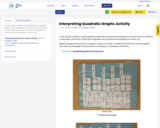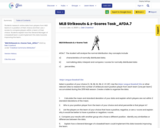
Students practice identifying the types of variation from equations and solving problems of different types of variation.
- Subject:
- Algebra I & II
- Material Type:
- Activity/Lab
- Author:
- Candice Barkley
- Date Added:
- 02/18/2021

Resources to support the Mathematics Standards of Learning for Algebra 2

Students practice identifying the types of variation from equations and solving problems of different types of variation.

This is a remix of a task to help students think about an expression for a function as built up out of simple operations on the variable, and understand the domain in terms of values for which each operation is invalid (e.g., dividing by zero or taking the square root of a negative number).

In this task, students decide which team wins the egg-launching contest by analyzing data from a table, graph and a verbal representation with a quadratic equation. In doing so, students analyze data, determine the equation of the curve of best fit in order to make predictions, and solve practical problems using models of quadratic functions.

Students will be introduced to the Empirical Rule for normal distributions and practice using it to answer questions.

Students evaluate functions with function notation both algebraically and graphically.

Students match features of exponential and logarithmic functions and then consider which features could change with a transformation. Features include: domain, range, intervals of increasing/decreasing, x- and y- intercepts, end behavior, and asymptotes.

Performing operations with radical expressions containing rational exponents Mathematics Instructional Plans (MIPs) help teachers align instruction with the 2016 Mathematics Standards of Learning (SOL) by providing examples of how the knowledge, skills and processes found in the SOL and curriculum framework can be presented to students in the classroom.

Students review domain, range, and intervals of increasing and decreasing using a draggable point to help them find extrema. Students find both absolute and relative extrema.

Factoring Polynomials Mathematics Instructional Plans (MIPs) help teachers align instruction with the 2016 Mathematics Standards of Learning (SOL) by providing examples of how the knowledge, skills and processes found in the SOL and curriculum framework can be presented to students in the classroom.

Exploring relationships among factors, zeros, and solutions Mathematics Instructional Plans (MIPs) help teachers align instruction with the 2016 Mathematics Standards of Learning (SOL) by providing examples of how the knowledge, skills and processes found in the SOL and curriculum framework can be presented to students in the classroom.

Finding domain and range, continuity, and end behavior for a given function Mathematics Instructional Plans (MIPs) help teachers align instruction with the Mathematics Standards of Learning (SOL) by providing examples of how the knowledge, skills and processes found in the SOL and curriculum framework can be presented to students in the classroom.

Finding extrema and intervals increasing and decreasing for a function Mathematics Instructional Plans (MIPs) help teachers align instruction with the Mathematics Standards of Learning (SOL) by providing examples of how the knowledge, skills and processes found in the SOL and curriculum framework can be presented to students in the classroom.

Students will explore the relationship between solutions, factors, and graphs of quadratic functions. They will participate in various activities to develop their understanding and practice.

Students will use IQ data to practice finding and interpreting z-scores.

Exploring asymptotes and discontinuity Mathematics Instructional Plans (MIPs) help teachers align instruction with the Mathematics Standards of Learning (SOL) by providing examples of how the knowledge, skills and processes found in the SOL and curriculum framework can be presented to students in the classroom.

In this activity, students use the graphs of quadratic functions and equations to find the zeros or solutions, y-intercepts, and factors. There are 10 equations or functions for the students to match-up.

Exploring Inverse Functions Mathematics Instructional Plans (MIPs) help teachers align instruction with the Mathematics Standards of Learning (SOL) by providing examples of how the knowledge, skills and processes found in the SOL and curriculum framework can be presented to students in the classroom.

Students are presented with four linear-quadratic systems of equations and must compare their answers from solving algebraically, looking at a table, and looking at a graph. When the solutions are non-integer solutions, they must explain how the table and graph confirm their algebraic solution.

Students research online data from players from MLB teams in a position of their choice and then use z-scores to compare players within a team of their choice. Students explain how the General Manager of a baseball team could implement this data towards improving the team.

This click and drag activity is a great practice for Algebra II students on multiplying and dividing radical expressions.